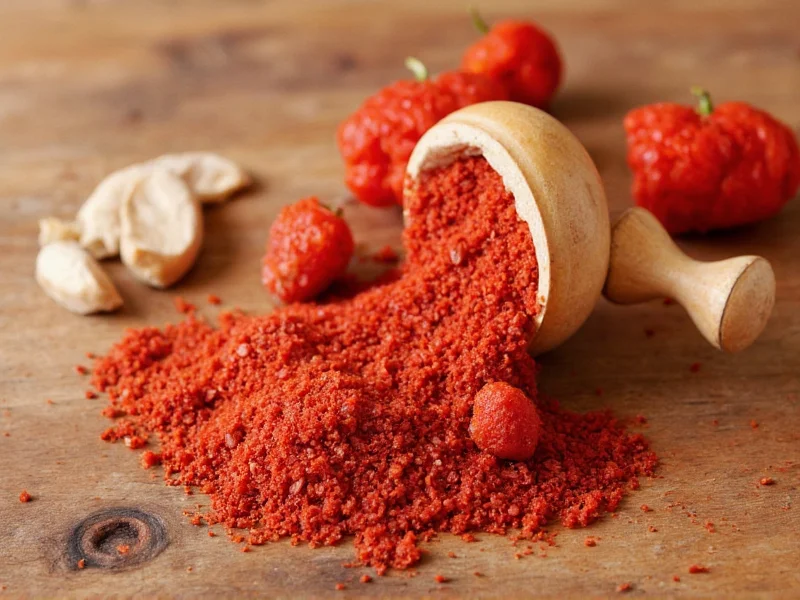When exploring authentic Mexican flavors, few combinations are as iconic as Tajín and chamoy. These two condiments have become cultural staples that transform ordinary snacks into extraordinary taste experiences. Tajín, with its distinctive red color and fine texture, delivers a zesty kick from dried chilies, lime, and salt. Chamoy, meanwhile, offers a complex sweet-sour-spicy profile made from pickled fruits, chilies, and spices. Understanding how these elements work together reveals why they've gained international popularity beyond their Mexican origins.
What Exactly Is Tajín?
Tajín (pronounced "tah-HEEN") is a Mexican seasoning blend that has become a global phenomenon. Created in 1985 by Horacio Fernández, this distinctive red powder contains three primary ingredients: ground chili peppers (primarily chiltepín and árbol varieties), dehydrated lime, and salt. The seasoning delivers a perfect balance of heat, tang, and saltiness without artificial flavors or colors.
Unlike many spice blends, Tajín contains no cumin, garlic, or other common Mexican seasonings. Its simplicity allows the natural flavors to shine through. The chilies provide mild to moderate heat (about 3,000-5,000 Scoville units), while the lime adds brightness and the salt enhances overall flavor perception. This versatile seasoning works exceptionally well on fruits, vegetables, and even in cocktail rims.
Understanding Chamoy: Mexico's Flavorful Sauce
Chamoy represents one of Mexico's most complex and beloved sauces, with roots tracing back to Asian influences through the Manila galleon trade. This sweet, sour, salty, and spicy condiment typically begins with pickled fruits like plums, apricots, or mangos, which are then blended with chilies, lime, and salt. The resulting sauce ranges from smooth liquid to thick paste depending on preparation.
Authentic chamoy varies significantly by region and producer. Some versions feature pronounced fruit flavors with subtle heat, while others deliver intense spiciness. The sauce's versatility makes it suitable for everything from dipping fresh fruit to enhancing street tacos. When properly balanced, chamoy creates a harmonious flavor experience where no single element overpowers the others.
The Perfect Flavor Pairing Explained
The magic of Tajín and chamoy together lies in their complementary flavor profiles. Tajín's dry seasoning provides immediate saltiness and tang that enhances the fruit's natural sweetness, while chamoy's liquid consistency carries complex flavors that penetrate deeper. This combination creates what food scientists call "flavor layering"—where multiple taste sensations build upon each other rather than competing.
| Flavor Component | Tajín Contribution | Chamoy Contribution |
|---|---|---|
| Sweetness | None | Primary (from fruit and sugar) |
| Sourness | High (lime) | Moderate (vinegar and fruit) |
| Saltiness | High | Moderate |
| Spiciness | Moderate (immediate) | Variety-dependent (lingering) |
| Umami | Low | Moderate (from fermentation) |
This complementary relationship explains why the combination works so well on fresh fruit—the Tajín enhances natural sweetness through salt while the chamoy adds complexity without overwhelming the fruit's flavor. The dry seasoning also helps the liquid chamoy adhere better to surfaces, creating a more uniform flavor distribution.
Traditional and Creative Applications
Mexican street vendors have perfected the art of combining Tajín and chamoy for generations. The most classic application involves fresh fruit cups where vendors generously coat mango, pineapple, watermelon, or jicama with both condiments. Street-style fruit typically features chamoy drizzled over the fruit with Tajín sprinkled on top, sometimes accompanied by a squeeze of fresh lime.
Beyond traditional fruit preparations, creative culinary applications have emerged:
- Fruit snacks: Toss sliced apples, cucumber, or watermelon with lime juice, then add chamoy and Tajín
- Popcorn: Mix melted butter with chamoy, toss with popped corn, then sprinkle generously with Tajín
- Cocktails: Rim glasses with lime juice and Tajín for micheladas or chamoy margaritas
- Snack enhancement: Elevate plain potato chips, gummy candies, or even popcorn with this flavor duo
- Desserts: Add complexity to sorbets, popsicles, or chocolate-dipped fruits
Cultural Significance and Global Expansion
While Tajín and chamoy have deep roots in Mexican culinary tradition, their popularity has expanded globally through Mexican diaspora communities. In regions with significant Mexican populations, finding authentic chamoy can be as simple as visiting a local tienda. Tajín's commercial success has made it more widely available internationally, appearing in mainstream grocery stores across North America and Europe.
The cultural significance extends beyond mere flavor—these condiments represent a sensory connection to Mexican identity. For many Mexican-Americans, the combination evokes memories of childhood street food experiences. This emotional resonance has contributed to their popularity as food trucks and Mexican restaurants introduce these flavors to new audiences worldwide.
Purchasing and Storage Tips
When shopping for authentic Tajín and chamoy, look for these indicators of quality:
- Tajín should list only chili peppers, lime, and salt in its ingredients
- Chamoy should contain recognizable fruit ingredients rather than artificial flavors
- Traditional chamoy often comes in glass bottles rather than plastic
- Higher quality chamoy may separate naturally—shake well before use
Proper storage extends shelf life significantly. Keep Tajín in a cool, dark place away from moisture—its dry nature means it rarely spoils but can lose potency over time. Chamoy requires refrigeration after opening; most commercial varieties contain preservatives that allow several months of freshness when properly stored. Homemade chamoy typically has a shorter shelf life and should be consumed within 2-3 weeks.











 浙公网安备
33010002000092号
浙公网安备
33010002000092号 浙B2-20120091-4
浙B2-20120091-4